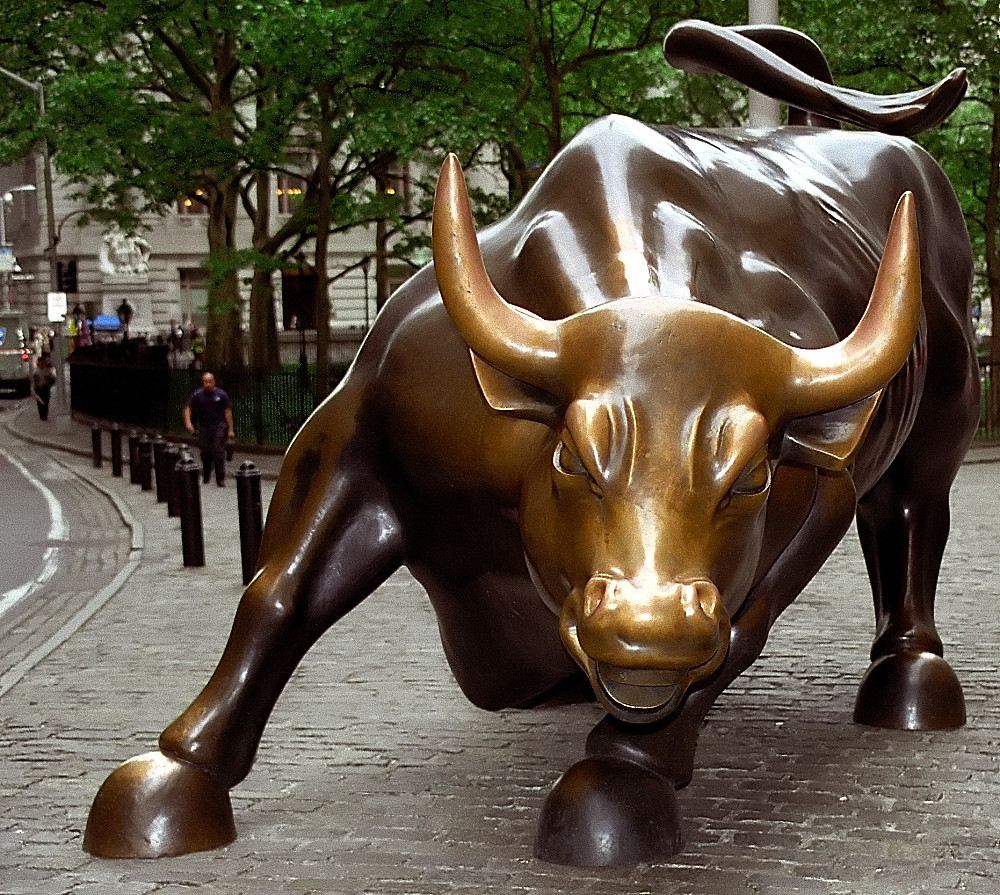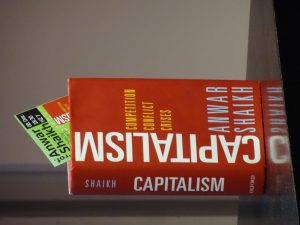Milton's Myth #8: Markets Are Efficient
✑ ROBIN HAHNEL | ± 4 minutes
Quite the opposite from what Milton Friedman would have us believe: Private enterprise and markets both cause unacceptable inequities and significant inefficiencies. (All of Milton's myths here).
When pressed, all economists concede that externalities, non-competitive market structures, and market disequilibria lead to allocative inefficiencies. Since mainstream economists take capitalism for granted, the debate among them is whether “market failure” or “government failure” is worse. That is, mainstream economists argue among themselves over whether government policies aimed at reducing inefficiencies due to externalities, non-competitive market structures, and disequilibria create even greater inefficiencies than those they eliminate. Conservative mainstream economists emphasize the dangers of government failure when politicians and bureaucrats sacrifice efficiency to their personal agendas. Liberal mainstream economists emphasize how much inefficiency due to market failures can be reduced by responsible government policies, if only opposition from business special interests can be overcome.
Sectoral imbalances pose a different kind of disequilibria and inefficiency. When an industry expands less rapidly than industries it buys from and sells to, it can become a “bottleneck” retarding overall growth and underutilizing productive capacities in related industries. Indicative planning or industrial policy attempts to reduce the inefficiency that results from sectoral imbalances by anticipating them and reducing them through differential tax and credit policies. Industries identified as bottlenecks are favored with lower business taxes and preferential credit to stimulate their growth, while “surplus industries” expanding more rapidly than related industries are discouraged by higher taxes and credit rationing in some form or another. Whether the government can guess better than the market, whether differential tax and credit policies are an invitation to corruption, and whether indicative planning reduces economic democracy as economic elites dominate the planning process are questions posed by mainstream and political economists alike.
In sum, quite the opposite from what Milton Friedman would have us believe: Private enterprise and markets both cause unacceptable inequities. Private enterprise and markets both cause significant inefficiencies. And private enterprise and markets both disenfranchise the vast majority from participating in economic decision making in proportion to the degree they are affected, and stand as a growing danger to, rather than a bulwark of, political liberty. As we explore in the next chapter, much can be done to ameliorate these deficiencies, and when well-conceived interventions are applied outcomes can be considerably improved. But mitigating damage is not the same as solving the root cause of problems, and mitigation won through herculean effort and sacrifice is always at risk of being undone when reform movements falter, weaken, or simply grow old.
This article is part of a list of refutations of ideas from Milton Friedman and mainstream economists in Robin Hahnel's book 'The ABC's of Political Economy' (2014). See all other myths already published on Socialist Economist here.
‟Free market exchange will often result in a misallocation of scarce productive resources.
Quite the opposite from what Milton Friedman would have us believe: Private enterprise and markets both cause unacceptable inequities and significant inefficiencies. (All of Milton's myths here).
Originally published in chapter ten of Hahnel's book The ABC's of Political Economy: A Modern Approach (Pluto Press, 2014).
|
|---|
About the author (click)
Robin Eric Hahnel (1946) is Professor Emeritus of Economics at American University in Washington DC. He has published on marxian economics, liberating theory, economic crises , ecological issues and “participatory economics”. He has frequently contributed to Znet and is the co-director of Economics for Equity and the Environment.
General introduction (click)
This article is part of a series refuting several myths of the neoliberal economist Milton Friedman (1912-2006), extracted from the book ABC's of Political Economy: A Modern Approach (Pluto Press, 2014) by economist Robin Hahnel. The general introduction was included in the first post of this series but can also be found here below↴
When Milton Friedman published Capitalism and Freedom (University of Chicago Press) in 1964 free market capitalism was not yet ascendant. In the post WWII era Keynesian, social democratic capitalism was more dominant, and government regulation and guidance of the economy was generally considered necessary, prudent, and desirable. So Friedman was writing as a dissident when he argued that only free market capitalism can provide economic freedom, promote political liberty, allocate resources efficiently, motivate people successfully, and reward people fairly, and government intervention was usually unnecessary and counterproductive.
By 2002 when the first edition of The ABCs of Political Economy was published neoliberal capitalism stood triumphant over the demise of not only centrally planned Communism, but social democratic, Keynesian capitalism as well. Friedman’s disciples were more confident than ever that free market capitalism was the best economy possible. Deregulation, privatization, and dismantling the social safety net had become the order of the day. Keynesians had been successfully isolated and silenced, and only a scattered tribe of “heterodox economists” any longer challenged Milton Friedman’s claims about the virtues of free market capitalism.
What a difference twelve years can make! While neoliberal capitalism still clings to power almost everywhere in 2014, and especially within the economics profession, there are now many who doubt that free market capitalism is truly the best economic system for the vast majority. Six years after the worst financial crash in four generations the global financial system remains without adequate regulation, and is just as dangerous as it was before the collapse of Lehman Bros. Five years after the largest drop in GDP since the Great Depression unemployment remains high in all the advanced economies with no end in sight. And despite overwhelming evidence that we are on course to unleash disastrous climate change, carbon emissions continue to rise everywhere. While the tongues of all but a few critics were tied in 2002, there are now many voices bemoaning the loss of hard won reforms neoliberals assured us were counterproductive, no longer necessary, or unaffordable. Every day more people are realizing that we are on course for an ecological disaster of Biblical proportions. As our “old economies” continue to fail us, there is rising interest in a potpourri of initiatives that are self-consciously not business-as-usual economics, called the “new” or “future” economy. And finally, there is a notable stirring of renewed interest in alternatives to capitalism altogether. However, it is still instructive to begin a careful evaluation of free market capitalism with a point-by-point response to Milton Friedman’s claims about its purported virtues that have grown to become popular myths about capitalism. After which we can see where criticisms raised by protest movements in Europe and the US during the past five years fit into the long, historic debate over the pros and cons of laissez faire capitalism.
When Milton Friedman published Capitalism and Freedom (University of Chicago Press) in 1964 free market capitalism was not yet ascendant. In the post WWII era Keynesian, social democratic capitalism was more dominant, and government regulation and guidance of the economy was generally considered necessary, prudent, and desirable. So Friedman was writing as a dissident when he argued that only free market capitalism can provide economic freedom, promote political liberty, allocate resources efficiently, motivate people successfully, and reward people fairly, and government intervention was usually unnecessary and counterproductive.
By 2002 when the first edition of The ABCs of Political Economy was published neoliberal capitalism stood triumphant over the demise of not only centrally planned Communism, but social democratic, Keynesian capitalism as well. Friedman’s disciples were more confident than ever that free market capitalism was the best economy possible. Deregulation, privatization, and dismantling the social safety net had become the order of the day. Keynesians had been successfully isolated and silenced, and only a scattered tribe of “heterodox economists” any longer challenged Milton Friedman’s claims about the virtues of free market capitalism.
What a difference twelve years can make! While neoliberal capitalism still clings to power almost everywhere in 2014, and especially within the economics profession, there are now many who doubt that free market capitalism is truly the best economic system for the vast majority. Six years after the worst financial crash in four generations the global financial system remains without adequate regulation, and is just as dangerous as it was before the collapse of Lehman Bros. Five years after the largest drop in GDP since the Great Depression unemployment remains high in all the advanced economies with no end in sight. And despite overwhelming evidence that we are on course to unleash disastrous climate change, carbon emissions continue to rise everywhere. While the tongues of all but a few critics were tied in 2002, there are now many voices bemoaning the loss of hard won reforms neoliberals assured us were counterproductive, no longer necessary, or unaffordable. Every day more people are realizing that we are on course for an ecological disaster of Biblical proportions. As our “old economies” continue to fail us, there is rising interest in a potpourri of initiatives that are self-consciously not business-as-usual economics, called the “new” or “future” economy. And finally, there is a notable stirring of renewed interest in alternatives to capitalism altogether. However, it is still instructive to begin a careful evaluation of free market capitalism with a point-by-point response to Milton Friedman’s claims about its purported virtues that have grown to become popular myths about capitalism. After which we can see where criticisms raised by protest movements in Europe and the US during the past five years fit into the long, historic debate over the pros and cons of laissez faire capitalism.
I
n Chapter 4 [of The ABC's of Political Economy] we explored all the reasons to believe markets are guided by a malevolent invisible foot as often as by a beneficent invisible hand when they allocate our scarce productive resources. We discovered that Milton Friedman and received wisdom notwithstanding, there are good reasons to believe markets allocate resources very inefficiently and concluded:
Convenient deals with mutual benefits for buyer and seller should not be confused with economic efficiency. When some kinds of preferences are consistently underrepresented because of transaction cost and free rider problems, when consumers adjust their preferences to biases in the market price system and thereby aggravate those biases, and when profits can be increased as often by externalizing costs onto parties external to market exchanges as from productive behavior, theory predicts free market exchange will often result in a misallocation of scarce productive resources. . . . Moreover, when markets are less than perfectly competitive – which they almost always are – and fail to equilibrate instantaneously – which they always do – the results are that much worse.
When pressed, all economists concede that externalities, non-competitive market structures, and market disequilibria lead to allocative inefficiencies. Since mainstream economists take capitalism for granted, the debate among them is whether “market failure” or “government failure” is worse. That is, mainstream economists argue among themselves over whether government policies aimed at reducing inefficiencies due to externalities, non-competitive market structures, and disequilibria create even greater inefficiencies than those they eliminate. Conservative mainstream economists emphasize the dangers of government failure when politicians and bureaucrats sacrifice efficiency to their personal agendas. Liberal mainstream economists emphasize how much inefficiency due to market failures can be reduced by responsible government policies, if only opposition from business special interests can be overcome.
‟When pressed, all economists concede that externalities, non-competitive market structures, and market disequilibria lead to allocative inefficiencies.Not surprisingly, political economists usually side with liberals in the mainstream in our attempts to ameliorate the inefficiencies and inequities of capitalism. But political economists also emphasize that as much as we try to reduce the ill effects of market failures, even the best efforts are likely to fall short of what a truly desirable economy could yield for a host of theoretical and practical reasons. While anti-trust policy can be used to make industries more competitive, they frequently sacrifice economies of scale and dynamic efficiency in service of allocative efficiency when they break up large firms. Moreover, even when the public interest is obviously served, anti-trust cases are hard to win when opposed by corporate power as the recent Microsoft anti-trust case attests. Using fiscal and monetary policies to “fine tune” real economies honeycombed with uncertainties and speculative dynamics impossible to capture in even the most elaborate macroeconomic forecasting models is far more difficult than theoretical models would lead one to suspect. Political economists also emphasize that an increasingly integrated global economy and powerful domestic business interests often obstruct effective fiscal and monetary policy.
Sectoral imbalances pose a different kind of disequilibria and inefficiency. When an industry expands less rapidly than industries it buys from and sells to, it can become a “bottleneck” retarding overall growth and underutilizing productive capacities in related industries. Indicative planning or industrial policy attempts to reduce the inefficiency that results from sectoral imbalances by anticipating them and reducing them through differential tax and credit policies. Industries identified as bottlenecks are favored with lower business taxes and preferential credit to stimulate their growth, while “surplus industries” expanding more rapidly than related industries are discouraged by higher taxes and credit rationing in some form or another. Whether the government can guess better than the market, whether differential tax and credit policies are an invitation to corruption, and whether indicative planning reduces economic democracy as economic elites dominate the planning process are questions posed by mainstream and political economists alike.
In sum, quite the opposite from what Milton Friedman would have us believe: Private enterprise and markets both cause unacceptable inequities. Private enterprise and markets both cause significant inefficiencies. And private enterprise and markets both disenfranchise the vast majority from participating in economic decision making in proportion to the degree they are affected, and stand as a growing danger to, rather than a bulwark of, political liberty. As we explore in the next chapter, much can be done to ameliorate these deficiencies, and when well-conceived interventions are applied outcomes can be considerably improved. But mitigating damage is not the same as solving the root cause of problems, and mitigation won through herculean effort and sacrifice is always at risk of being undone when reform movements falter, weaken, or simply grow old.
This article is part of a list of refutations of ideas from Milton Friedman and mainstream economists in Robin Hahnel's book 'The ABC's of Political Economy' (2014). See all other myths already published on Socialist Economist here.
























Comments
Post a Comment
Your thoughts...